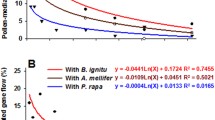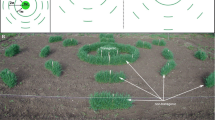Abstract
Genetically modified (GM) sugarcane is being developed for use in commercial production in several countries. Regulatory approval is required before these cultivars can be released and grown. Part of the approval process is to understand and assess the potential for environmental harm that might result from introduction of a GM organism. A key piece of biological information to assist in this analysis is to determine if and over what distance transgenes could be transferred by pollen from the GM plants and passed onto the next generation of sugarcane seeds. This is not known for sugarcane. Consequently, a field experiment was designed and conducted in Australia to determine the level of pollination between sugarcane cultivars (Saccharum spp. hybrids), and the distance over which it occurs, by placing non-GM flowering plants of cultivar  in the centre of a field of non-GM cultivar
in the centre of a field of non-GM cultivar  . Mature inflorescences of the pollen receptor (
. Mature inflorescences of the pollen receptor ( ) were collected in eight directions up to 200 m from the centre of the field. Parentage of the seeds from the mother plants germinating in controlled conditions was determined by molecular markers. At a distance of 1 m in all directions from the pollen source, relatively high levels of hybridisation were found, though this was highest (100%) in the upwind direction. The level of hybridisation decreased in the shape of an exponential decay curve but detectable levels of hybridisation still occurred at 200 m downwind from the pollen source. The high level of cross- pollination at close distance was confirmed in a second experiment. The potential for pollen to travel several hundred metres and effect pollination and the subsequent production of sugarcane seeds means that containment of a transgene by distance cannot be assumed for sugarcane. The potential for cross- pollination of sugarcane plants or of compatible, sympatric relatives will be dependent upon local conditions. The risk of harm as a result of pollen carrying a transgene subsequently pollinating and producing seed will have to be evaluated against the likelihood of germination and survival of the seed and the nature and effects of the transgene.
) were collected in eight directions up to 200 m from the centre of the field. Parentage of the seeds from the mother plants germinating in controlled conditions was determined by molecular markers. At a distance of 1 m in all directions from the pollen source, relatively high levels of hybridisation were found, though this was highest (100%) in the upwind direction. The level of hybridisation decreased in the shape of an exponential decay curve but detectable levels of hybridisation still occurred at 200 m downwind from the pollen source. The high level of cross- pollination at close distance was confirmed in a second experiment. The potential for pollen to travel several hundred metres and effect pollination and the subsequent production of sugarcane seeds means that containment of a transgene by distance cannot be assumed for sugarcane. The potential for cross- pollination of sugarcane plants or of compatible, sympatric relatives will be dependent upon local conditions. The risk of harm as a result of pollen carrying a transgene subsequently pollinating and producing seed will have to be evaluated against the likelihood of germination and survival of the seed and the nature and effects of the transgene.


Similar content being viewed by others
Abbreviations
- GM:
-
Genetically modified
References
Aitken KS, Jackson PA, McIntyre CL (2005) A combination of AFLP and SSR markers provides extensive map coverage and identification of homo(eo)logous linkage groups in a sugarcane cultivar. Theor Appl Genet 110:789–801
Aitken KS, McNeil MD, Hermann S, Bundock PC, Kilian A, Heller-Uszynska K, Henry RJ, Li JC (2014) A comprehensive genetic map of sugarcane that provides enhanced map coverage and integrates high throughput Diversity Array Technology (DArT) markers. BMC Genomics 15:152. https://doi.org/10.1186/1471-2164-15-152
Arencibia AD, Carmona ER, Cornide MT, Castiglione S, O’Relly J, Chinea A, Oramas P, Sala F (1999) Somaclonal variation in insect-resistant transgenic sugarcane (Saccharum hybrid) plants produced by cell electroporation. Transgenic Res 8:349–360. https://doi.org/10.1023/A:1008900230144
Bannert M, Stamp P (2007) Cross-pollination of maize at long distance. Eur J Agron 27:44–51. https://doi.org/10.1016/j.eja.2007.01.002
Basnayake SWV, Morgan TC, Wu L, Birch RG (2012) Field performance of transgenic sugarcane expressing isomaltulose synthase. Plant Biotechnol J 10:217–225. https://doi.org/10.1111/j.1467-7652.2011.00655.x
Berding N (1981) Improved flowering and pollen fertility in sugarcane under increased night temperatures. Crop Sci 21:863–867
Berding N (1995) Improving flowering of sugarcane for breeding: progress and prospects. Proc Aust Soc Sugar Cane Technol 17:162–171
Blackburn F (1984) Chapter 2: Botany. In: Wrigley G (ed) Sugar-cane. Longman, London, pp 30–42
Bonnett GD, Olivares-Villegas JJ, Berding N, Morgan T (2010) Sugarcane sexual reproduction in a commercial environment: research to underpin regulatory decisions for genetically modified sugarcane. Proc of the Aust Soc Sugar Cane Technol 32:1–9
Brett PGC (1951) Flowering and pollen fertility in relation to sugarcane breeding in Natal. Proc Int Soc Sugar Cane Tech 7:43–56
Chaturvedi M, Datta K (2001) Pollen morphology in Saccharum L. (Poaceae) - wild and cultivated sugar cane species. Feddes Repert 112:387–390. https://doi.org/10.1002/fedr.4921120509
Cheavegatti-Gianotto A, de Abreu HMC, Arruda P, Bespalhok Filho JC, Burnquist WL, Creste S, di Ciero L, Ferro JA, de Oliveira Figueira AV, de Sousa GM, Filgueiras T (2011) Sugarcane (Saccharum X officinarum): a reference study for the regulation of genetically modified cultivars in Brazil. Trop Plant Biol 4:62–89. https://doi.org/10.1007/s12042-011-9068-3
Cordeiro GM, Taylor GO, Henry RJ (2000) Characterisation of microsatellite markers from sugarcane (Saccharum sp.), a highly polyploid species. Plant Sci 155:161–168
Dal-Bianco M, Carneiro MS, Hotta CT, Chapola RG, Hoffmann HP, Garcia AAF, Souza GM (2012) Sugarcane improvement: how far can we go? Curr Opin Biotechnol 23:265–270. https://doi.org/10.1016/j.copbio.2011.09.002
Ferrante A, Savin R, Slafer GA (2013) Floret development and grain setting differences between modern durum wheats under contrasting nitrogen availability. J Exp Bot 64:169–184. https://doi.org/10.1093/jxb/ers320
Grivet L, Arruda A (2001) Sugarcane genomics: depicting the complex genome of an important tropical crop. Curr Opin Plant Biol 5:122–127
Hüsken A, Dietz-Pfeilstetter A (2007) Pollen-mediated intraspecific gene flow from herbicide resistant oilseed rape (Brassica napus L.). Transgenic Res 16:557–569. https://doi.org/10.1007/s11248-007-9078-y
Jaffe G (2004) Regulating transgenic crops: a comparative analysis of different regulatory processes. Transgenic Res 13:5–19. https://doi.org/10.1023/B:TRAG.0000017198.80801.fb
Kennedy RD, Cheavegatti-Gianotto A, de Oliveira WS, Lirette RP, Hjelle JJ (2018) A general safety assessment for purified food ingredients derived from biotechnology crops: case study of Brazilian sugar and beverages produced from insect-protected sugarcane. Front Bioeng Biotechnol 6:45
Lakshmanan P, Geijskes RJ, Aitken KS, Grof CLP, Bonnett GD, Smith GR (2005) Sugarcane biotechnology: the challenges and opportunities. In Vitro Cell Dev Biol - Plant 41:345–363. https://doi.org/10.1079/IVP2005643
Liebbrandt NB, Snyman SJ (2003) Stability of gene expression and agronomic performance of a transgenic herbicide-resistant sugarcane line in South Africa. Crop Sci 43:671–677
Madan P, Jagadish SVK, Craufurd PQ, Fitzgerald M, Lafarge T, Wheeler TR (2012) Effect of elevated CO2 and high temperature on seed-set and grain quality of rice. J Exp Bot 63:3843–3852. https://doi.org/10.1093/jxb/ers077
McIntyre CL, Jackson PA (2001) Low level of selfing found in a sample of crosses in Australian sugarcane breeding programs. Euphytica 117:245–249
Moore PH (1976) Studies on sugarcane pollen 2. Pollen storage. Phyton 34:71–80
OECD (2016) Chapter 2 Sugarcane. In: Safety Assessment of Transgenic Organisms in the Environment, Volume 6: OECD Consensus Documents, Harmonisation of Regulatory Oversight in Biotechnology. OECD Publishing, Paris. https://doi.org/10.1787/9789264253421-en
Oka HI (1988) Ecology and population biology of the common wild rice. In: Origins of cultivated Rice. Elsevier Science. https://doi.org/10.1016/B978-0-444-98919-2.50009-0
Parris GK (1954) Discoverer of sugarcane seedlings. Garden J NY Bot Gard 6:144–151
Pierre JS, Rae AL, Bonnett GD (2014) Abiotic limits for germination of sugarcane seed in relation to environmental spread. Trop Plant Biol 7:100–110. https://doi.org/10.1007/s12042-014-9141-9
Pierre JS, Perroux J, Whan A, Rae AL, Bonnett GD (2015) Poor fertility, short longevity and low abundance in the soil seed bank limit volunteer sugarcane from seed. Front Bioeng Biotechnol 3:63
Price S (1961) Germination of true seed of sugarcane. Sugarcane Breeders’ Newsl 8:19–23
Rao P (1980) Fertility, seed storage and seed viability in sugarcane. Proc Int Soc Sugar Cane Tech 17:1236–1240
Ray JD, Kilen TC, Abel CA, Paris RL (2003) Soybean natural cross-pollination rates under field conditions. Environ Biosaf Res 2:133–138. https://doi.org/10.1051/ebr:2003005
Roach BT (1989) Evaluation and breeding use of sugarcane germplasm. Proc Int Soc Sugar Cane Tech 20:492–502
Rühl G, Langhof M (2011) Coexistence in maize: effect of the genetically modified maize depth on pollen-mediated gene flow. Crop Sci 51:2186–2193. https://doi.org/10.2135/cropsci2011.01.0037
Saghaimaroof MA, Soliman KM, Jorgensen RA (1984) Ribosomal DNA spacer-length polymorphisms in barley – Mendelian inheritance, chromosomal location, and population dynamics. PNAS 81:8014–8018
Sambrook J, Fritsch EF, Maniatis T (1989) Molecular cloning: a laboratory manual, 2nd edn. Cold Spring Harbour Laboratory Press
Shaver DL (1962) A study of aneuploidy in autotetraploid maize. Can J Genet Cytol 4:226–233
Skinner JC (1959) Controlled pollination of sugarcane. Bur Sug Exp Stas Q Tech Comm 1:1–20
Tew TL, Pan YB (2010) Microsatellite (simple sequence repeat) marker–based paternity analysis of a seven-parent sugarcane polycross. Crop Sci 50:1401. https://doi.org/10.2135/cropsci2009.10.0579
van Deynze AE, Sundstrom FJ, Bradford KJ (2005) Pollen-mediated gene flow in California cotton depends on pollinator activity. Crop Sci 45:1565–1570. https://doi.org/10.2135/cropsci2004.0463
Venkatraman RSTS (1922) Germination and preservation of sugarcane pollen. Agric J India 17:127–132
Verret JA, Kutsunai Y, Das UK, Covant R, Smith T (1925) A method of handling cane tassels for breeding work. Hawaiian Planter’s Record 29:84–95
Waltz E (2014) Beating the heat. Nat Biotechnol 32:610–613. https://doi.org/10.1038/nbt.2948
Wang ML, Goldstein C, Su W, Moore PH, Albert HH (2005) Production of biologically active GM-CSF in sugarcane: a secure biofactory. Transgenic Res 14:167–178. https://doi.org/10.1007/s11248-004-5415-6
Weng LX, Deng HH, Xu JL, Li Q, Zhang YQ, Jiang ZD, Li QW, Chen JW, Zhang LH (2011) Transgenic sugarcane plants expressing high levels of modified cry1Ac provide effective control against stem borers in field trials. Transgenic Res 20:759–772. https://doi.org/10.1007/s11248-010-9456-8
Xanthopoulos FP, Kechagia UE (2000) Natural crossing in cotton (Gossypium hirsutum L.). Aust J Agric Res 51:979–983. https://doi.org/10.1071/AR00026
Acknowledgements
The authors would like to thank David Wallis (Mulgrave Mill) for site selection, Heidi Clements, Ross McIntyre, Warren Owens, Rhylee Pendrigh, Vivienne Dunne and Nathan Symonds (Sugar Research Australia - previously BSES Limited) for assistance with the setting up and analysis of the field experiments. The Australian government contributed to this research through the Australian Cooperative Research Centre for Sugar Industry Innovation through Biotechnology and the Sugar Research and Development Corporation (now Sugar Research Australia) through project CRC 005.
Author information
Authors and Affiliations
Corresponding author
Additional information
Communicated by: Paulo Arruda
Publisher’s Note
Springer Nature remains neutral with regard to jurisdictional claims in published maps and institutional affiliations.
Rights and permissions
About this article
Cite this article
Olivares-Villegas, J.J., Pierre, J., Perroux, J. et al. Determination of in-Field Gene Flow Between Sugarcane Cultivars. Tropical Plant Biol. 13, 127–135 (2020). https://doi.org/10.1007/s12042-019-09237-z
Received:
Accepted:
Published:
Issue Date:
DOI: https://doi.org/10.1007/s12042-019-09237-z




